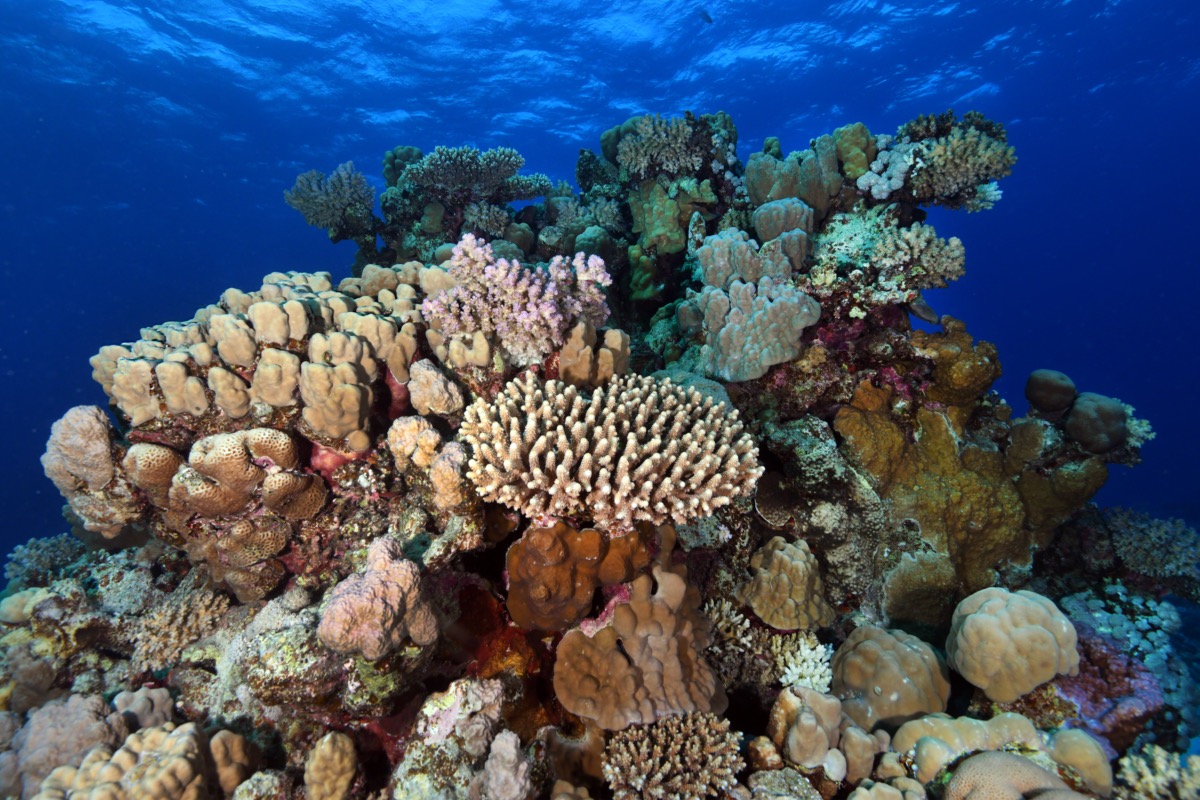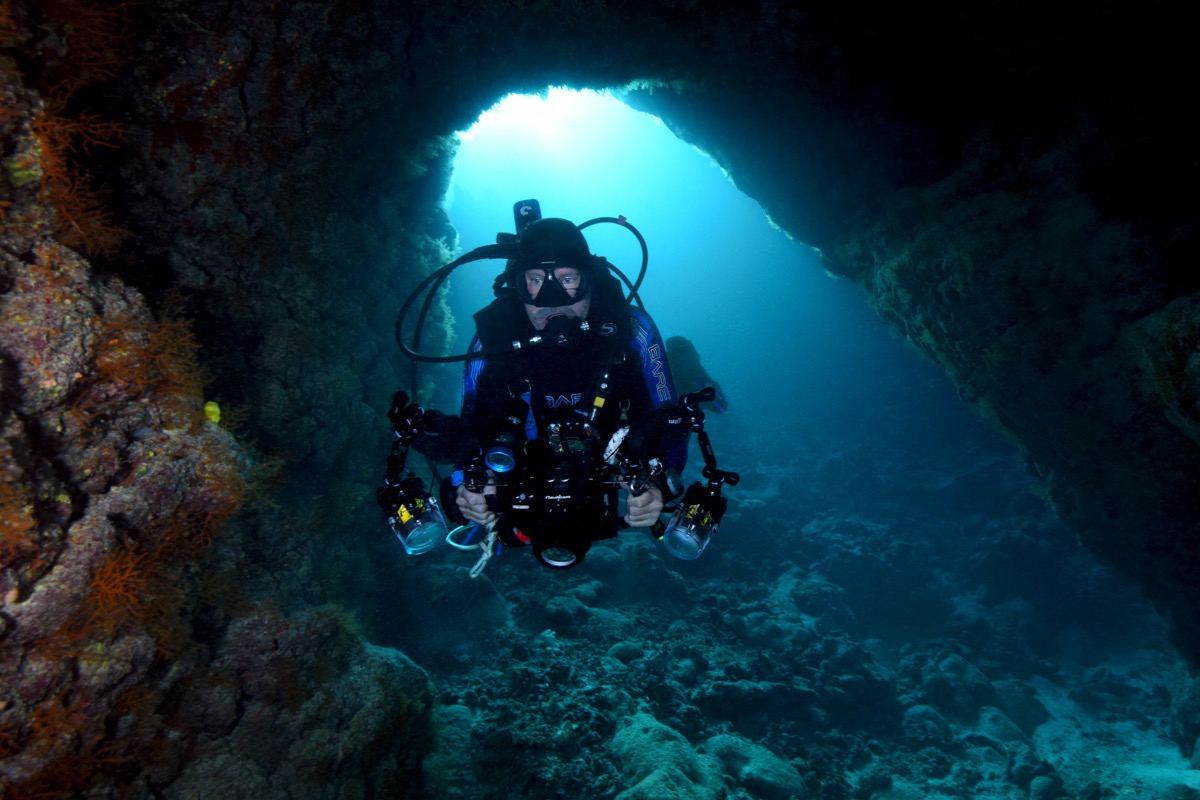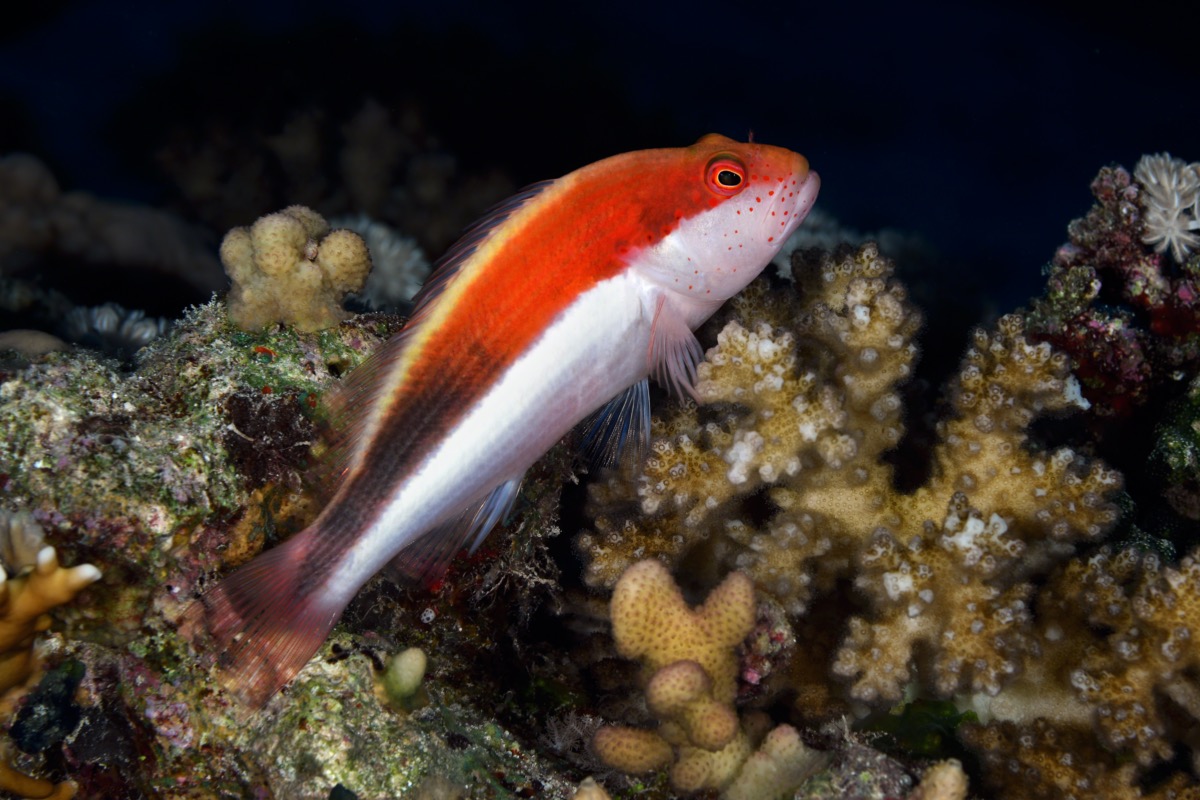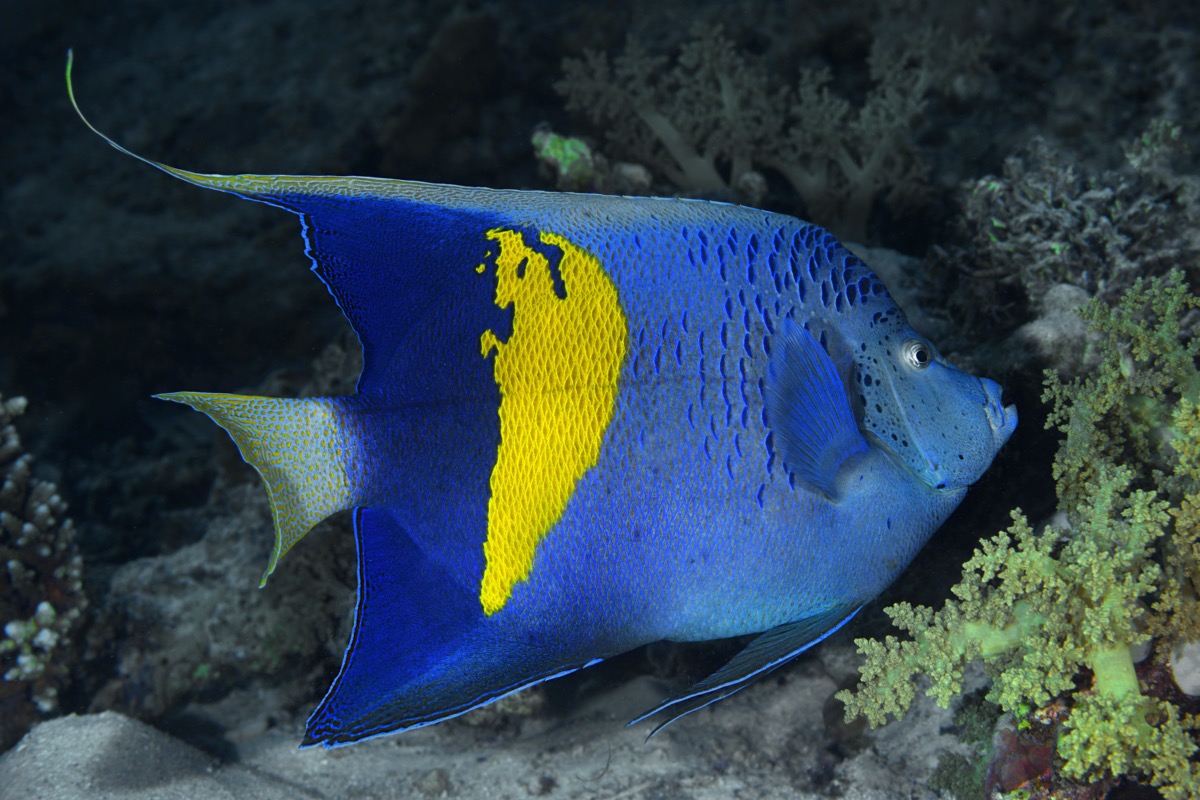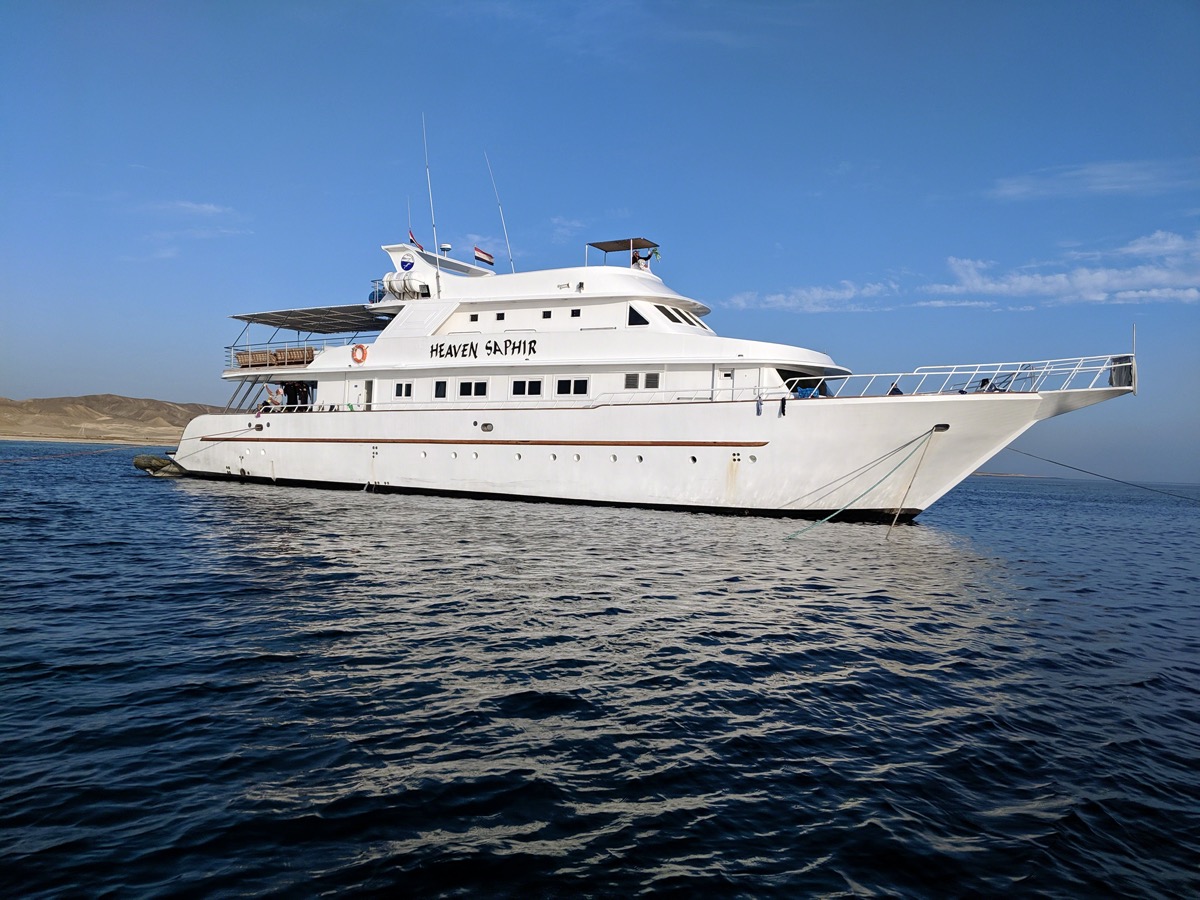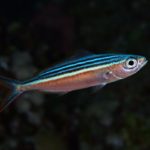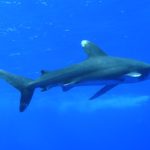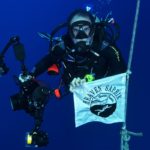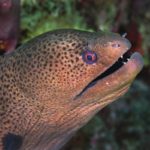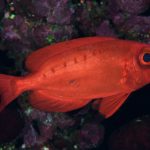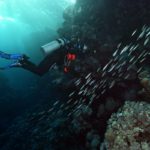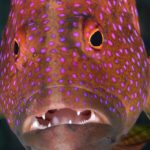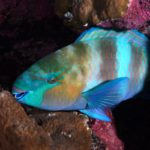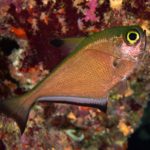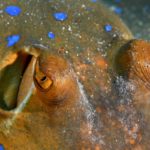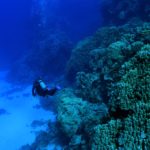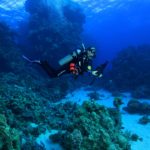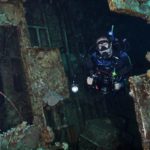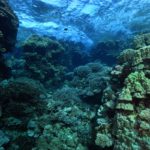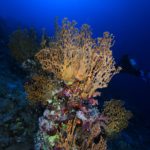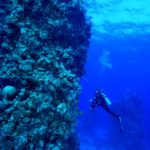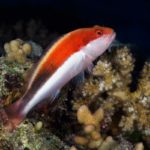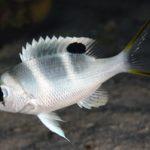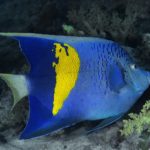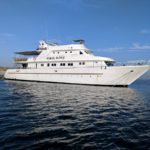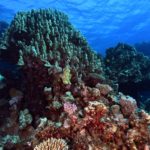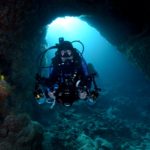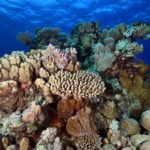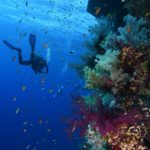People have been coming to Egypt for thousands of years. From the time of the earliest settlers in the Nile Valley around 3500 BC, through the various dynasties of the old and new kingdoms, and including the periods of conquest by the Romans, Arabs and Ottoman Turks, Egypt has been a focal point of the civilized world for its cultural and material riches.
Words & Photos by Michael Salvarezza & Christopher P. Weaver
Of course, our journey here included stops at the Pyramids of Giza, the Great Sphynx and the Museum of Egypt to see the vast collections of antiquities on display. But the purpose of our visit was to seek a different Egyptian treasure. We were here to dive the southern Red Sea, with the less often visited St. John’s Reef and Fury Shoals region our main area of focus. And we were here to see an Oceanic Whitetip Shark.
After a 10 hour flight from New York to Cairo, followed by a 1 hour flight to Hurghada and a frantic 3 hour drive down the coast to Port Ghalib, we boarded the 118 foot (36m) liveaboard M/Y Heaven Saphir and set out on our dive safari to the south.
The Heaven Saphir is one of a several dive boats operating out of this area and as we strolled along the docks in Port Ghalib before boarding, we could not help but notice that many of them appeared worn, old and tired. Not so with the Heaven Saphir, a fresh looking and handsome vessel that accommodates a maximum of 19 guests in comfortable cabins, each with a fridge, shower and individually controlled air conditioning. With plentiful, delicious food, a friendly and attentive crew and a pair of experienced dive guides on board, our week on the Red Sea was about to begin.
After a checkout dive at Marsa Shauna, we motored 14 hours south towards the St. John’s Reef area. It was November, and the Egyptian winds were kicking up choppy seas and some rolling swells. The air was dry and clear with very pleasant temperatures. We arrived in the morning and before long we were drifting along the walls of Farsha Umm Kararem, a coral pinnacle with a precipitous dropoff. Healthy hard corals and clouds of brilliantly colored Anthias greeted our travel weary eyes and the dive safari was on!
One of the things we discovered over the next few days of diving is that, while we weren’t encountering big schools of pelagic fish, the real secret to the beauty of this body of water is that most of the species we were seeing were endemic to this region. After each dive, the fish geeks on board would pore over the boat’s Coral Reef Guide Books, compare notes, and excitedly exclaim after identifying a new species to their dive experiences. We were among those geeks!
Dangerous Reef was our next stop and here we made an afternoon dive followed by a night dive. Our quarry on this dive was the flamboyant Spanish Dancer, a brilliantly colored red Nudibranch that can measure up to a foot in length. About halfway into the dive, with dive lights flashing in the darkness along the coral gardens, we suddenly came across the distinctive ribbon-like egg case of this creature and we thought “there must be one nearby!”
A few moments later, there she was: a majestic Spanish Dancer creeping its way along a coral outcropping. Later, we would find three more. Afterwards, on board the Heaven Saphir, one of the divers approached us and told us of a friend who was sick with cancer who always had a dream of seeing a Spanish Dancer but never had. Could we give her one of our images? We were only too happy to oblige.
At dive sites like the Big and Little Gota, Paradise Reef and The Playground, we explored reefs known for their geological splendor. Dramatic, spindly pinnacles rose 60 feet from the sea floor resembling coral skyscrapers while cracks in the coral reef created exhilarating swim throughs. All along these craggy coral structures we spotted more endemic species, including the Red Sea Anemonefish flitting amongst the tentacles of an anemone at the mouth of one of the swim throughs. We also spotted the Crown Butterflyfish, the Arabian Butterflyfish and the aptly named Exquisite Butterflyfish at various points in the dive.
Our dive routine aboard the Heaven Saphir started with a wakeup knock on our cabin door at 6am. A dive briefing at 6:30am would be held followed by a dive before breakfast. After a surface interval, we would enjoy a late morning dive, followed by lunch and then an afternoon dive which would precede a night dive. By then, a hearty dinner was in order and was enjoyed by all.
Green Sea Turtles, Bluespotted Stingrays and free-swimming Giant Moray Eels were among the larger creatures we came across. The southern waters, however, are more suited for macro photography, with numerous opportunities to capture images of reef fish, invertebrates, nudibranchs and hard and soft corals.
As we made our way north on the way back towards Port Ghalib, we stopped at additional dive sites like Abu Galawa Soraya and Shiriniat. More coral outcroppings, more endemic species but, to this point, no Oceanic Whitetips! Also, as we explored closer to Port Ghlaib we encountered more dive boats and crowded conditions on the reefs. We had always heard about the boat traffic at some of the Red Sea sites but we were still surprised at the number of boats that were simultaneously mooring at these sites. With zodiacs buzzing back and forth, and with multiple boats moored in the area, an SMB is an essential tool for diver safety. The dive leaders from Heaven Saphir
were no stranger to these situations and made sure to minimize the effects of this sometimes chaotic situation by timing our dives optimally and ensuring that we surfaced right by the boat.
On our final day of the safari, we arrived at Elphinstone, a dive site near Marsa Alam known for shark sitings. With strong currents, the site is generally for more advanced divers. With an eye towards the open water, we drifted along dramatic coral formations photographing various marine life but ever hopeful for the shark siting we had been waiting for. We did not spot a shark on this dive but, instead, became obsessed with capturing a good image of the Red Sea’s endemic Orchid Dottyback, a one inch purplish-blue colored fish that inhabits most of the reef. This fish seemed to know precisely when the shutter was about to be released because that’s when they would dart away and getting a good image was quite difficult! We’re not sure we ever really got one.
With a change in current direction, we made a second dive at Elphinstone to explore a different side of the reef. Here we found dazzling soft corals blooming in the current amongst healthy hard corals of various species and colors. A Titan Triggerfish swam out from behind a ledge to give us a look while a Lyre-Tail Grouper literally stared us down as we tried to swim through its territory. Groups of Sergeant Majors excitedly protected their egg masses from predators and from the bubble blowing divers who were passing by. The reef seemed alive with buzzing activity on this late morning in the Red Sea.
Our second jaunt around Elphinstone was quite enjoyable, but it was at the very end of the dive, as we waited out our three-minute safety stop, that we finally caught a glimpse of our week-long target. There, hazy at first but then clearer as she got closer, a six-foot Oceanic Whitetip Shark drifted in from the open ocean, took a curious glance at the gaggle of divers hovering at 15 feet, and confidently swam off into the blue. With our hearts racing, and our fists pumping in the water, we watched her distinctive pectoral fins and powerful tail slowly fade into the distance as she beckoned us to follow her to explore more of the Red Sea and search for treasures yet unseen. We know we will follow her at some point.
Getting There
Mike and Chris flew Egyptair direct from New York to Cairo and then to Hurghada. There are numerous flights from Europe into Cairo and Hurghada. Marsa Alam is closer to Port Ghalib but the flight schedules may not be as convenient. Hurghada is a 3-hour drive from Port Ghalib.
Diving and Accommodation
Mike and Chris dove with the M/Y Heaven Saphir liveaboard. This was an 8-day southern Red Sea itinerary that costs from $1300 per person and was all inclusive, including transfers, accommodations, diving and food. Nitrox is available for an extra fee. Divers wishing to rent equipment, including larger size tanks, can make those arrangements prior to arriving at the boat.
When to go
The dive season runs all year, with windier conditions and cooler temperatures between November and April. In the summer months, temperatures can sometimes be uncomfortably warm but the diving conditions are excellent.
Words & Photos by Michael Salvarezza & Christopher P. Weaver
.
- A Striated Fusilier
- The Oceanic Whitetip is an impressive looking shark
- The Heaven Saphir is a top quality liveaboard
- As its name implies, the Giant Moray is the largest Moray Eel
- Bigeyes are usually found near caves
- Photo opportunities abound
- The LyreTail Grouper showing its teeth
- A Bluebarred Parrotfish peers out from a coral head
- Groups of Vanikoro Sweeper fish are sometimes found in dark sheltered areas of the reef
- The Blue Spotted Stingray inhabits sandy areas of the reef
- A school of Blue-Green Chromis seek shelter in a coral head
- The Amphitheater dive site
- Divers should avoid the venomous spines of the Lionfish
- Author Mike Salvarezza drifts among coral pinnacles
- Divers examine a small shipwreck
- The River Nile runs through Cairo
- A majestic Mosque in Cairo
- The coral jungle near the surface
- A friendly greeting
- The Great Sphynx of Egypt
- Coral reefs make for interesting images
- Mike Salvarezza examines a coral pinnacle
- Anthias swarm over the corals
- Anthias swarm over the corals
- Freckled Hawkfish perched atop a hard coral
- At night some fish are more easily approached
- The Yellowbar Angelfish is quite striking
- The Heaven Saphir liveaboard
- Take time to ride a camel
- amels and Pyramids, icons of Egypt
- Interesting coral formations greet the divers
- Exploring the coral pinnacles
- The coral jungle
- Author Christopher Weaver explores a rocky swimthrough
- Healthy hard corals of the Red Sea
- Sheer walls make forgreat dives



